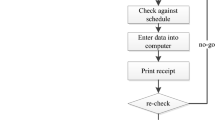Abstract
This research concentrates on integrated modeling of supply chain and information system through a unique integrated meta-heuristic computer simulation algorithm. It uses computer simulation and genetic algorithm in order to select suppliers and new facilities by reducing delivery time and final production cost. To reach these goals, this research has simulated an actual case study with simulation and in the other stages, has moved forward to improve and optimize the objectives by focusing on selection of suppliers. It also uses the collective information to reduce total cycle time and cost simultaneously. Moreover, a dynamic model is designed to determine the status of new facilities. The dynamic model is solved by genetic algorithm focusing on the time and cost reduction as the main objectives of the problem. Results show the effectiveness of the integrated algorithm. This is the first study that uses a hybrid meta-heuristic approach for integrated design of information system and supply chain.
Similar content being viewed by others
References
Ambrosino D, Scutella MG (2005) Distribution network design: new problems and related models. Eur J Oper Res 165:610–624
Amid A, Ghodsypour SH, O'Brien C (2006) Fuzzy multiobjective linear model for supplier selection in a supply chain. Int J Prod Econ 104(2):394–407
Amid A, Ghodsypour SH, O'Brien C (2011) Weighted max–min model for fuzzy multi-objective supplier selection in a supply chain. Int J Prod Econ 131(1):139–145
Azadeh A, Haghnevis M, Khodadadegan M (2008) Design of the integrated information system, business and production process by simulation. J Am Soc Inf Sci Technol 59(2):216–234
Baatz EB (1995) Best practice: the chain gang. CIO 8:46–52
Ballou RH (1968) Dynamic warehouse location analysis. J Mark Res 5:271–276
Beamon BM (1998) Supply chain design and analysis: models and methods. Int J Prod Econ 55:281–294
Bottani E, Rizzi A (2008) An adapted multi-criteria approach to suppliers and products selection—an application oriented to lead-time reduction. Int J Prod Econ 111(2):763–781
Canel C, Khumawala BM, Law J, Loh A (2001) An algorithm for the capacitated, multi-commodity multi-period facility location problem. Comput Oper Res 28:411–427
Chang B, Hung HF (2010) A study of using RST to create the supplier selection model and decision-making rules. Expert Syst Appl 37:8284–8295
Che ZH, Wang HS (2008) Supplier selection and supply quantity allocation of common and non-common parts with multiple criteria under multiple products. Comput Ind Eng 55(1):110–133
Chen YJ (2011) Structured methodology for supplier selection and evaluation in a supply chain. Inf Sci 181(9):1651–1670
Christanthi A (2001) Information systems: what sort of science is it? Omega 28(5):567–579
Cordeau JF, Pasin F, Solomon MM (2006) An integrated model for logistics network design. Ann Oper Res 1:59–82
Cortinhal MJ, Captivo ME (2003) Upper and lower bounds for the single source capacitated location problem. Eur J Oper Res 151:333–351
Dahal KP, Galloway SJ, Burt GM, McDonald JR (2001) Generation scheduling using genetic algorithm based hybrid techniques. LESCOPE '01, Conference on 107 Large Engineering Systems in Power Engineering, pp. 74–78
Daskin M, Snyder L, Berger R (2005) Logistics Systems: Design and Optimization. Chapter 2, Springer US, pp 39–65
Dias J, Captivo ME, Climaco J (2006) Capacitated dynamic location problems with opening, closure and reopening of facilities. IMA J Manag Math 4:317–348
Farmer D (1997) Purchasing myopia – revisited. Eur J Purch Supply Manag 3:1–8
Farzipoor Saen R (2010) Restricting weights in supplier selection decisions in the presence of dual-role factors. Appl Math Model 34:2820–2830
Feng B, Fan ZP, Zhili Y (2011) A decision method for supplier selection in multi-service outsourcing. Int J Prod Econ 132:240–250
Filho VJMF, Galvão RD (1998) A tab u search heuristic for the concentrator location problem. Locat Sci 6:189–209
Goldberg DE (1989) Genetic algorithms in search, optimization, and machine learning. Addison-Wesley, Reading
Lee HL, Padmanabhan V, Whang S (1997) Information distortion in a supply chain: the bullwhip effect. Manag Sci 43:546–559
Ha SH, Krishnan R (2008) A hybrid approach to supplier selection for the maintenance of a competitive supply chain. Expert Syst Appl 34(2):1303–1311
Hamer-Lavoie G, Cordeau JF (2006) Un modè le pour la conception d'un re´seau de distribution avec localisation, affectation et stocks. INFOR 44:99–115
Haralambos S, Chris DT (2008) Dynamic modeling and control of supply chain system: a review. Comput Oper Res 35:3530–3561
Harland CM (1996) Supply chain management. Relationships, and networks. Br J Manag 7:68–80
He Y, Hui C-W (2010) A binary coding genetic algorithm for multi-purpose process scheduling: a case study. Chem Eng Sci 65(16):4816–4828
Hinojosa Y, Puerto J (2006) Dynamic supply chain design with inventory. Comput Oper Res 35:373–391
Hinojosa Y, Puerto J, Ferna FR (2000) A multi-period two-echelon multi-commodity capacitated plant location problem. Eur J Oper Res 123:271–291
Hirschheim R, Klein H, Lyytinen K (1995) Information systems development and data modeling: conceptual and philosophical foundations. Cambridge University Press, p 289
Hou J, Su D (2006) Integration of Web Services technology with business models within the total product design process for supplier selection. Comput Ind 58(8–9):797–808
Hyun JK, Gerald WE (2007) A genetic algorithm-based heuristic for the dynamic integrated forward/reverse logistics network for 3PLs. Comput Oper Res 34:346–366
Inman RA, Hubler JH (1992) Certify the process, not just the product. Prod Invent Manag J 33:11–14
Jaramillio JH, Bhadury J, Batta R (2002) On the use of genetic algorithms to solve location problems. Comput Oper Res 29:761–779
Jardin A, Dejax P, Péton O (2006) A dynamic model for the strategic design of complex supply chains. Research Report 06/4/AUTO, Ecole des Mines de Nantes-IRCCyN
Jayaram J, Vickery SK, Droge C (1999) An empirical study of time-based competition in the North America automotive supplier industry. Int J Oper Prod Man 19(10):1010–1033
Kokangul A, Susuz Z (2009) Integrated analytical hierarch process and mathematical programming to supplier selection problem with quantity discount. Appl Math Model 33:1417–1429
Krarup J, Pruzan PM (1983) The simple plant location problem: survey and synthesis. Eur J Oper Res 12:36–81
Lam K-C, Tao R, Lam MC (2010) A material supplier selection model for property developers using Fuzzy Principal Component Analysis. Autom Constr 19(5):608–618
Li L, Zabinsky ZB (2011) Incorporating uncertainty into a supplier selection problem. Int J Prod Econ 134:344–356
Luis P, Jose ML (2007) Capturing dynamics in integrated supply chain management. Comput Chem Eng 32(11):2582–2605
Luo X, Wu C, Rosenberg D, Barnes D (2009) Supplier selection in agile supply chains: an information-processing model and an illustration. J Purch Supply Manag 15(4):249–262
Martel A (2005) The design of production–distribution networks: A mathematical programming approach. In: Geunes J, Pardalos PM (eds) Supply Chain Optimization, Springer, Berlin et al., pp 265–306
Melachrinoudis E, Min H (2000) The dynamic relocation and phase-out of a hybrid, two-echelon plant/warehousing facility: a multiple objective approach. Eur J Oper Res 123:1–15
Melkote S, Daskin MS (2001) Theory and methodology facility location/network design problems. Eur J Oper Res 129:481–495
Melo MT, Nickel S, Saldanha da Gama F (2005) Dynamic multi-commodity capacitated facility location: a mathematical modelling framework for strategic supply chain planning. Comput Oper Res 33:181–208
Ongsakal W, Ruangpayoongsak N (2001) Constrained dynamic economic dispatch by simulated annealing/genetic algorithms. Power Industry Computer Applications, 207–212
Paquet M, Martel A, Desaulniers G (2004) Including technology selection decisions in manufacturing network design models. Int J Comput Integr Manuf 17(2):117–125
Geunes J, Pardalos PM (eds) Supply Chain Optimization. Springer, Berlin, pp 265–306
Phoung NT, Nathalia B (2007) A dynamic model for facility location in the design of supply chain. Int J Prod Econ 113:678–693
Pritsker AB (1990) Papers, experiences and perspectives. Systems Publishing Corporation, Lafayette
Pritsker AB, Oreilly JJ, LaVal DK (1997) Simulation with Visual Slam and AweSim. John Wiley, New York
Pritsker AB, Sigal CE, Hammesfahr RDJ (1989) Network models for decision support. Prentice-Hall, New York
Shemshadi A, Shirazi H, Toreihi M, Tarokh MJ (2011) A fuzzy VIKOR method for supplier selection based on entropy measure for objective weighting. Expert Syst Appl 38(10):12160–12167
Tsai YL, Yang YJ, Lin C (2010) A dynamic decision approach for supplier selection using ant colony system. Expert Syst Appl 37:8313–8321
Tseng M-L, Chiang JH, Lan AW (2009) Selection of optimal supplier in supply chain management strategy with analytic network process and Choquet integral. Comput Ind Eng 57(1):330–340
Ustun O, Demirtas EA (2007) Multi-period lot-sizing with supplier selection using achievement scalarizing functions. Comput Ind Eng 54(4):918–931
Vanteddu G, Chinnam RB, Gushikin O (2009) Supply chain focus dependent supplier selection problem. Int J Prod Econ 129(1):204–216
Vila D, Martel A, Beauregard R (2006) Designing logistics networks in divergent process industries: a methodology and its application to the lumber industry. Int J Prod Econ 102(2):358–378
Wikipedia (2004) Genetic algorithm. Available from URL: http://en.wikipedia.org/wiki/Genetic_algorithm
Wu WY, Sukoco BM, Li CY, Chen SH (2009) An integrated multi-objective decision-making process for supplier selection with bundling problem. Expert Syst Appl 36:2327–2337
Zachman JA (1987) A framework for information system architecture. IBM Syst J 26(3):276–292
Author information
Authors and Affiliations
Corresponding author
Rights and permissions
About this article
Cite this article
Azadeh, A., Keramati, A., Karimi, A. et al. Design of integrated information system and supply chain for selection of new facility and suppliers by a unique hybrid meta-heuristic computer simulation algorithm. Int J Adv Manuf Technol 71, 775–793 (2014). https://doi.org/10.1007/s00170-013-5417-8
Received:
Accepted:
Published:
Issue Date:
DOI: https://doi.org/10.1007/s00170-013-5417-8




